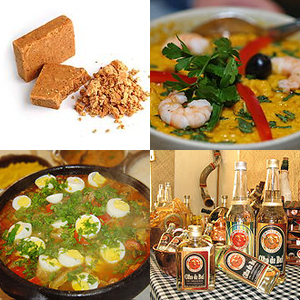The South
Sundried meat, salted meat, arroz carreteiro (meat and rice), barreado (meat stew) and the churrasco (barbeques) are commonly found here.
European immigrants introduced leafy green vegetables, dairy products and wine into the local cuisine and the local sweet manioc replaces sweet potatoes.
The South East
This region consists of Espírito Santo, Minas Gerais, Rio de Janeiro and São Paulo the capital city and centre of industry.
The most popular foods in Minas Gerais are chicken, especially frango com quiabo (chicken with okra, beans, maize and pork) and a plethora of soft, traditional local cheeses.
In Rio, the national dish feijoada, a bean and meat stew, was born from a stew that was made by African slaves, as was feijão com arroz (rice and beans).
Black beans are preferred in Rio and brown (rajadinho or carioquinha) beans in São Paulo.
One of the most interesting dishes found in São Paulo is the Virado à Paulista, made with a combination of rice, tutu de feijão couve (sautéed collard greens) and pork chops (preferably bisteca which is the name for the pork equivalent of a T-bone steak).The dish is served with pork rinds, chunks of sausage and a fried egg and banana.
The regional dish of Espírito Santo is Moqueca Capixaba (a tomato and fish stew prepared in a clay pot).
North
Tucupi is a yellow liquid extracted from the manioc root using a tipiti (a straw press).
It’s typically boiled with herbs and is a basic ingredient in many dishes.
Pato no tucupi (duck in tucupi) is made for Círio de Nazaré which is one of the biggest Catholic festivals in Brazil. On this day a whole duck is oven roasted until golden brown and tender, then cut into chunks and simmered in tucupi sauce seasoned with garlic and herbs.
Tamuata in tucupi – the tamuata is a horny-scaled catfish typically found in the Amazon River. It’s thoroughly scrubbed, seasoned with fresh lemon and salt and boiled in tucupi sauce seasoned with herbs. To serve, stir in parboiled jambu leaves and white rice, manioc meal and pepper.
Tacacá is similar to pato no tucupi but made with shrimps and jambú, flavoured with garlic and chillies.
Caruru is made when peeled dried shrimps are sautéed with garlic, onions, chicory, flour and dendê (African palm oil). Water is added and it’s left to simmer, then thickened with sifted manioc meal and plenty of sliced okra.
Vatapá consists of dried, salted shrimps which are peeled and sautéed with onion, tomatoes, green onions and dendê, before the coconut milk is added.It is thickened with rice or wheat flour and served with white rice and/ or boiled jambu leaves.
Maniçoba is made when ground manioc leaves (maniva) are simmered over a long period of time – at least 4 days. Cubes of jerked beef, bacon, a variety of spicy sausages, chopped tripe, veal shanks, salted pig’s ribs (sometimes even ears or paws) are added and then served with white rice, manioc meal and pimenta-de-cheiro (fragrant pepper).
Pirarucu in coconut milk is served with white rice and manioc meal after it has been re-hydrated and desalted. Thick slices are simmered in coconut milk. The dish can also be made from the white liquid extracted from fresh Brazil nuts (also known as para-nuts.)
Crab Toc Toc consists of whole, live crabs which are boiled in water and seasoned with salt, fresh lemon juice and garlic and served hot in the shell.
Barreado is a meat stew served with rice and is prepared by cooking it in a terracotta pot underground for about 20 hours, creating a rich thick sauce.
The pot is layered with banana leaves and sealed with hardened manioc flour paste to avoid the heat from escaping.
North East
The coastal regions are rich in tropical vegetables and fruit, sugarcane and cacao.
The predominant cuisine in Bahia is Afro-Bahian, a fusion of African, American-Indian and traditional Portuguese food, cooked with available local ingredients.
Acarajé is a salted muffin made with white beans and onions and fried in dendê and is filled with dried shrimps or chillies, caruru, smoked shrimps, pepper and garlic.
White rice and black beans are the staple food in this region as well as, seafood, shellfish, coconuts and tropical fruit.
Throwing a Brazilian-style bash? Click here to see Food24’s Brazilian party menu!

